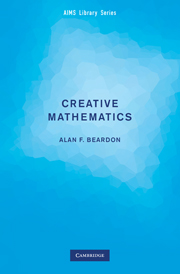5 - Problem A: Solution
Published online by Cambridge University Press: 16 May 2024
Summary
Suppose that 0 < L1 ≤ L2 ≤ L3. Then there is a triangle with sides of lengths L1, L2 and L3 if and only if L3 ≤ L1 + L2. We leave the proof to the reader, but we remark that it is better to express this inequality in the form
2max﹛L1,L2,L3﹜ ≤ tgyb L1 + L2 + L3,
as this does not require the Lj to be labelled in any particular way.
Many mathematical problems have two parts: (i) does a solution exist, and (ii) if it exists is it unique? Sometimes, if a solution is not unique we can characterise the set of all solutions in some way. The usual way to tackle the problem of existence is first to assume that the solution does exist. Then, working from this assumption, we gain some insight into some of the properties that the solution must have, and sometimes we can even find an explicit solution. After we have found what we believe to be a solution it is essential to check that our answer is indeed a solution. This is the only way to be sure that our final answer does not depend on the earlier assumption (which has served its purpose in giving a greater insight into the problem).
Let us now return to the problem of the circles and ask (i) does such a set of circles exist, and (ii) if it does, are the radii uniquely determined by the triangle?
First, we consider the case when each circle lies outside the other two circles. Let the lengths of the sides of the triangle be L1, L2 and L3, and suppose that we draw circles of radii r1, r2 and r3, with the circle of radius rj centred at the vertex of the triangle opposite the side of length Lj (see Figure 6). The circles are externally tangent to each other if and
only if there is a solution to the simultaneous equations
in which all of the rj are positive. This system of equations has a unique solution given by
- Type
- Chapter
- Information
- Creative MathematicsA Gateway to Research, pp. 29 - 32Publisher: Cambridge University PressPrint publication year: 2009



